Beko DN 142100, DN 143100, DN 142103T User manual

DN 142100
DN 143100
DN 142103T
Refrigerator
Congélateur/réfrigérateur
Ledusskapis
Please read this user manual first!
Dear Customer,
We hope that your product, which has been produced in modern plants and checked under the most meticulous quality control procedures, will provide you an effective service.
Therefore, read this entire user manual carefully before using the product and keep it as a reference. If you handover the product to someone else, give the user manual as well.
The user manual will help you use the product in a fast and safe way.
•Read the manual before installing and operating the product.
•Make sure you read the safety instructions.
•Keep the manual in an easily accessible place as you may need it later.
•Read the other documents given with the product.
Remember that this user manual is also applicable for several other models. Differences between models will be identified in the manual.
Explanation of symbols
Throughout this user manual the following symbols are used:
CImportant information or useful tips.
AWarning against dangerous conditions for life and property. BWarning against electric voltage.

CONTENTS
1 |
Your refrigerator |
3 |
2 |
Important Safety |
|
Warnings |
4 |
|
Intended use...................................... |
4 |
|
General safety................................... |
4 |
|
For products with a water dispenser;. 6 |
||
Child safety........................................ |
6 |
|
Compliance with the AEEE Regulation and Disposing of the Waste Product.. 6
Package information.......................... |
6 |
HCA warning...................................... |
7 |
Things to be done for energy saving... |
7 |
Recommendations for the fresh food |
|
compartment..................................... |
8 |
3 Installation |
9 |
Points to be paid attention to when the |
|
relocation of the refrigerator................ |
9 |
Before you start the refrigerator,......... 9 |
|
Electrical connection.......................... |
9 |
Changing the illumination lamp ........ |
10 |
Adjusting the legs............................. |
10 |
Disposing of the packaging.............. |
10 |
Disposing of your old refrigerator...... |
10 |
Placing and Installation..................... |
10 |
Reversing the doors......................... |
11 |
Reversing the doors......................... |
12 |
4 |
Preparation |
13 |
5 |
Using your refrigerator 14 |
|
Fridge compartment temperature |
|
|
setting button .................................. |
14 |
|
Freezer compartment temperature |
|
|
setting button .................................. |
15 |
|
Making ice........................................ |
15 |
|
Crisper humidity control sliders......... |
16 |
|
Using the rotary crisper (in some |
|
|
models)............................................ |
16 |
|
Freezing fresh food........................... |
17 |
|
Recommendations for preservation of |
||
frozen food....................................... |
17 |
|
Placing the food............................... |
18 |
|
Deep-freeze information................... |
18 |
|
6 |
Maintenance and |
|
cleaning |
19 |
|
Protection of plastic surfaces .......... |
19 |
|
7 |
Troubleshooting |
20 |
2 EN
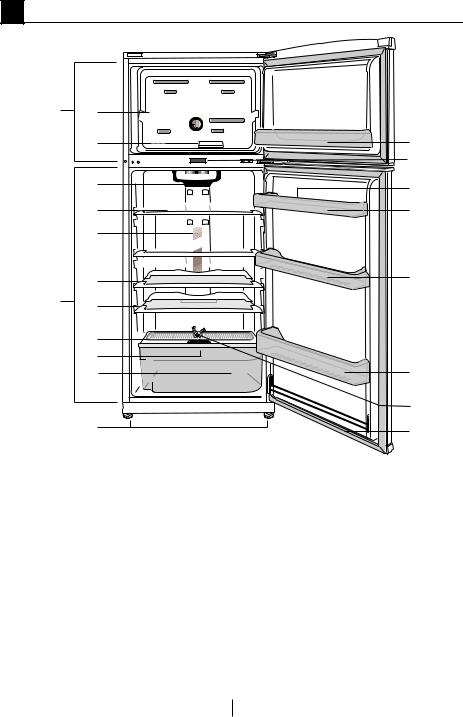
1 Your refrigerator
141 
*2 


3 


4 
5 
4 

4
154
6
7
*8
9
10
*13
11
12
12
12
*13
12
1- |
Freezer compartment shelf |
9- |
Adjustable legs |
2- |
Ice container |
10- |
Freezer compartment door |
3- |
Fridge compartment |
shelf |
|
temperature setting button |
11- |
Egg tray |
|
4- |
Adjustable body shelves |
12- |
Fridge compartment door |
5- |
Illumination lens |
shelf |
|
6- |
Crisper cover |
13- |
Key |
7- |
Crisper humidity control slider |
14- |
Freezer compartment |
8- |
Crisper |
15- |
Fridge compartment |
* OPTIONAL
C Figures that take place in this instruction manual are schematic and may not correspond exactly with your product. If the subject parts are not included in the product you have purchased, then it is valid for other models.
3 EN

2 Important Safety Warnings
Please review the following information. Failure to observe this information may cause injuries or material damage. Otherwise, all warranty and reliability commitments will become invalid.
The service life of your product is 10 years. During this period, original spare parts will be available to operate the product properly.
Intended use
This product is intended to be used
•indoors and in closed areas such as homes;
•in closed working environments such as stores and offices;
•in closed accommodation areas such as farm houses, hotels, pensions.
•It should not be used outdoors.
General safety
•When you want to dispose/scrap the product, we recommend you to consult the authorized service in
order to learn the required information and authorized bodies.
•Consult your authorized service for all your questions and problems related to the refrigerator. Do not intervene or let someone intervene to the refrigerator without notifying the authorised services.
•For products with a freezer compartment; Do not eat cone ice cream and ice cubes immediately after you take them out of the freezer compartment! (This may cause frostbite in your mouth.)
•For products with a freezer compartment; Do not put bottled and canned liquid beverages in the freezer compartment. Otherwise, these may burst.
•Do not touch frozen food by hand; they may stick to your hand.
•Unplug your refrigerator before cleaning or defrosting.
•Vapor and vaporized cleaning materials should never be used in cleaning and defrosting processes of your refrigerator. In such cases, the vapor may get in contact with the electrical parts and cause short circuit or electric shock.
•Never use the parts on your refrigerator such as the door as a means of support or step.
•Do not use electrical devices inside the refrigerator.
•Do not damage the parts, where the refrigerant is circulating, with
drilling or cutting tools. The refrigerant that might blow out when the gas channels of the evaporator, pipe extensions or surface coatings are punctured causes skin irritations and eye injuries.
•Do not cover or block the ventilation holes on your refrigerator with any material.
•Electrical devices must be repaired by only authorised persons. Repairs performed by incompetent persons create a risk for the user.
•In case of any failure or during a maintenance or repair work,
disconnect your refrigerator’s mains supply by either turning off the relevant fuse or unplugging your appliance.
4 EN
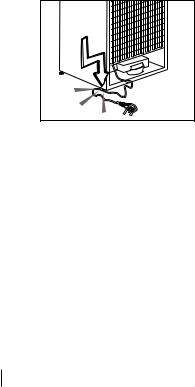
•Do not pull by the cable when pulling off the plug.
•Place the beverage with higher proofs tightly closed and vertically.
•Never store spray cans containing flammable and explosive substances in the refrigerator.
•Do not use mechanical devices or other means to accelerate the
defrosting process, other than those recommended by the manufacturer.
•This product is not intended to be used by persons with physical, sensory or mental disorders or unlearned or inexperienced people (including children) unless they are attended by a person who will be responsible for their safety or who will instruct them accordingly for use of the product
•Do not operate a damaged refrigerator. Consult with the service agent if you have any concerns.
•Electrical safety of your refrigerator shall be guaranteed only if the earth system in your house complies with standards.
•Exposing the product to rain, snow, sun and wind is dangerous with respect to electrical safety.
•Contact authorized service when there is a power cable damage to avoid danger.
•Never plug the refrigerator into the wall outlet during installation. Otherwise, risk of death or serious injury may arise.
•This refrigerator is intended for only storing food items. It must not be used for any other purpose.
•Label of technical specifications is located on the left wall inside the refrigerator.
•Never connect your refrigerator to electricity-saving systems; they may damage the refrigerator.
•If there is a blue light on the refrigerator, do not look at the blue light with optical tools.
•For manually controlled refrigerators, wait for at least 5 minutes to start the refrigerator after power failure.
•This operation manual should be handed in to the new owner of the product when it is given to others.
•Avoid causing damage on power cable when transporting the refrigerator. Bending cable may cause fire. Never place heavy objects on power cable.
•Do not touch the plug with wet hands when plugging the product.
•Do not plug the refrigerator if the wall outlet is loose.
•Water should not be sprayed on inner or outer parts of the product for safety purposes.
•Do not spray substances containing inflammable gases such as propane gas near the refrigerator to avoid fire and explosion risk.
•Never place containers filled with water on top of the refrigerator; in the event of spillages, this may cause electric shock or fire.
5 EN

•Do not overload the refrigerator with food. If overloaded, the food items may fall down and hurt you and damage refrigerator when you open the door.
•Never place objects on top of the refrigerator; otherwise, these objects may fall down when you open or close the refrigerator's door.
•As they require a precise temperature, vaccines, heat-sensitive medicine and scientific materials and etc. should not be kept in the refrigerator.
•If not to be used for a long time, refrigerator should be unplugged. A possible problem in power cable may cause fire.
•The plug's tip should be cleaned regularly with a dry cloth; otherwise, it may cause fire.
•Refrigerator may move if adjustable legs are not properly secured on the floor. Properly securing adjustable legs on the floor can prevent the refrigerator to move.
•When carrying the refrigerator, do not hold it from door handle. Otherwise, it may be snapped.
•When you have to place your product next to another refrigerator or freezer, the distance between devices should be at least 8cm. Otherwise, adjacent side walls may be humidified.
For products with a water dispenser;
Pressure of water mains should be minimum 1 bar. Pressure of water mains should be maximum 8 bars.
• Use only potable water.
Child safety
•If the door has a lock, the key should be kept away from reach of children.
6
•Children must be supervised to prevent them from tampering with the product.
Compliance with the AEEE Regulation and Disposing of the Waste Product
This product does not contain harmful and forbidden materials described
in the "Regulation on the Control of the Waste Electrical and Electronic Equipment" issued by the T.R. Ministry of Environment and City Planning. Complies with the AEEE Regulation.
This product has been
manufactured with high quality parts and materials
which can be reused and are suitable for recycling.
Therefore, do not dispose the product with normal
domestic waste at the end of its service life. Take it to a collection point for the recycling of electrical and electronic equipment. Please consult your local authorities to learn the nearest collection point. Help protect the environment and natural resources by recycling used products. For children's safety, cut the power cable and break the locking mechanism of the door, if any, so that it will be nonfunctional before disposing of the product.
Package information
Packaging materials of the product are manufactured from recyclable materials in accordance with our National Environment Regulations. Do not dispose of the packaging materials together with the domestic or other wastes. Take them to the packaging material collection points designated by the local authorities.
Do not forget...
EN

Any recycled substance is an indispensable matter for nature and our national asset wealth.
If you want to contribute to the re-evaluation of the packaging materials, you can consult to your environmentalist organizations or the municipalities where you are located.
HCA warning
If your product's cooling system contains R600a:
This gas is flammable. Therefore, pay attention to not damaging the cooling system and piping during usage and transportation. In the event of damage, keep your product away from potential fire sources that can cause the product catch a fire and ventilate the room in which the unit is placed.
Ignore this warning if your product's cooling system contains R134a.
Type of gas used in the product is stated in the type label which is on the left wall inside the refrigerator.
Never throw the product in fire for disposal.
Things to be done for energy saving
•Do not leave the doors of your refrigerator open for a long time.
•Do not put hot food or drinks in your refrigerator.
•Do not overload your refrigerator so that the air circulation inside of it is not prevented.
•Do not install your refrigerator under direct sunlight or near heat emitting appliances such as ovens, dishwashers or radiators. Keep your refrigerator at least 30cm away from heat emitting sources and at least 5cm from electrical ovens.
•Pay attention to keep your food in closed containers.
•For products with a freezer compartment; You can store maximum amount of food items in the freezer when you remove the shelf or drawer of the freezer. Energy consumption value stated for your refrigerator has been determined
by removing freezer shelf or drawer and under maximum load. There is no harm to use a shelf or drawer
according to the shapes and size of food to be frozen.
•Thawing frozen food in fridge compartment will both provide energy saving and preserve the food quality.
7 EN
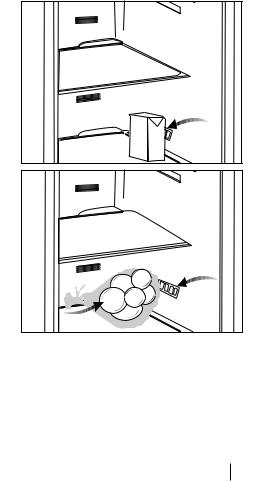
Recommendations for the fresh food compartment
*optional
•Do not allow the food to touch the temperature sensor in fresh food compartment. To allow the fresh food compartment keep its ideal storage temperature, sensor must not be hindered by food.
•Do not place hot foods in the product.
MILK juice etc.
temperature sensor
food |
temperature |
sensor |
8 EN
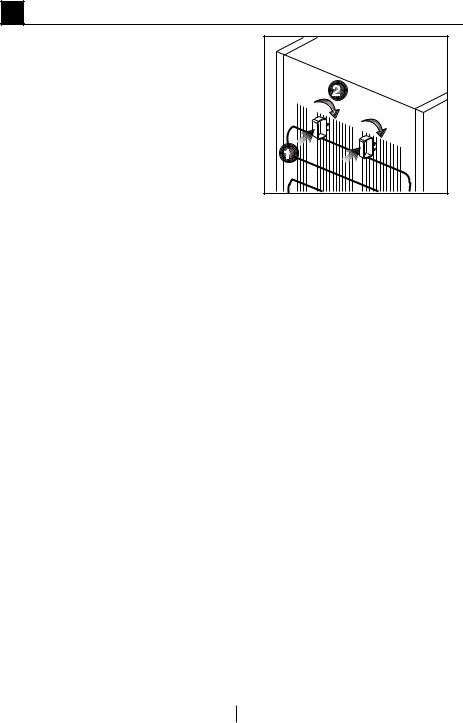
3 Installation
B In case the information which are given in the user manual are not taken into account, manufacturer will
not assume any liability for this.
Points to be paid attention to when the relocation of the refrigerator
1.Your refrigerator should be unplugged.Before transportation of your refrigerator, it should be emptied and cleaned.
2.Before it is re-packaged, shelves, accessories, crisper, etc. inside your refrigerator should be fixed with adhesive tape and secured against impacts. Package should be bound with a thick tape or sound ropes and the transportation rules on the package should be strictly observed.
3.Original packaging and foam materials should be kept for future transportations or moving.
Before you start the refrigerator,
Check the following before you start to use your refrigerator:
1.Attach 2 plastic wedges as illustrated below. Plastic wedges are intended to keep the distance which will ensure the air circulation between your refrigerator and the wall. (The picture is drawn up as a representation and it is not identical with your product.)
2.Clean the interior of the refrigerator as recommended in the “Maintenance and cleaning” section.
3.Connect the plug of the refrigerator to the wall socket. When the fridge door is opened, fridge internal lamp will turn on.
4.When the compressor starts to operate, a sound will be heard. The liquid and gases sealed within the refrigeration system may also give rise to noise, even if the compressor is not running and this is quite normal.
5.Front edges of the refrigerator may feel warm. This is normal. These areas are designed to be warm to avoid
condensation.
Electrical connection
Connect your product to a grounded socket which is being protected by a fuse with the appropriate capacity.
Important:
The connection must be in compliance with national regulations.
•The power plug must be easily accessible after installation.
•Electrical safety of your refrigerator shall be guaranteed only if the earth system in your house complies with standards.
•The voltage stated on the label located at left inner side of your product should be equal to your network voltage.
•Extension cables and multi plugs must not be used for connection.
9 EN
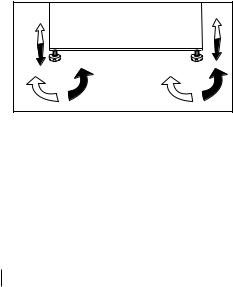
B A damaged power cable must be replaced by a qualified electrician.
B Product must not be operated before it is repaired! There is the risk of
electric shock!
Disposing of the packaging
The packing materials may be dangerous for children. Keep the packing materials out of the reach of children or dispose of them by
classifying them in accordance with the waste instructions stated by your local authorities. Do not throw away with regular house waste, throw away on packaging pick up spots designated by the local authorities.
The packing of your refrigerator is produced from recyclable materials.
Disposing of your old refrigerator
Dispose of your old refrigerator without giving any harm to the environment.
•You may consult your authorized dealer or waste collection center of your municipality about the disposal of your refrigerator.
Before disposing of your refrigerator, cut out the electric plug and, if there are any locks on the door, make them inoperable in order to protect children against any danger.
Placing and Installation
A If the entrance door of the room where the refrigerator will be installed is not wide enough for the refrigerator to pass through, then call the authorized service to have them remove the doors of your refrigerator and pass it sideways through the door.
1. Install your refrigerator to a place that allows ease of use.
2.Keep your refrigerator away from heat sources, humid places and direct sunlight.
3.There must be appropriate air ventilation around your refrigerator in order to achieve an efficient operation. If the refrigerator is to be placed in a recess in the wall, there must be at least 5 cm distance with the ceiling and at least 5 cm with the wall. Do not place your product on the materials such as rug or carpet.
4.Place your refrigerator on an even floor surface to prevent jolts.
Adjusting the legs
If your refrigerator is unbalanced;
You can balance your refrigerator by turning its front legs as illustrated in the figure. The corner where the leg exists is lowered when you turn in the direction of black arrow and raised when you turn in the opposite
direction. Taking help from someone to slightly lift the refrigerator will facilitate this process.
Changing the illumination lamp
To change the Bulb/LED used for illumination of your refrigerator, call your Authorized Service.
10 EN
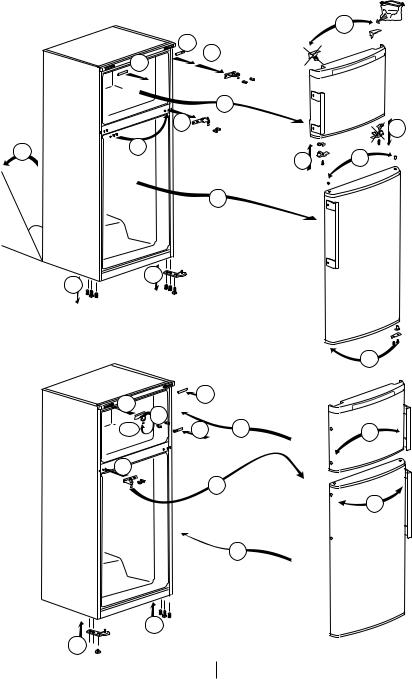
Reversing the doors |
|
|
|
Proceed in numerical order . |
|
|
|
|
|
|
10 |
|
|
4 |
|
|
4 |
5 |
|
|
|
|
|
|
|
2 |
|
|
|
1 |
12 |
|
|
|
|
7 |
6 |
11 |
13 |
|
|||
|
|
||
3
45°
9
8
14
18
19



 17
17
180° |
19 |
22 |
24 |
|
|
|
23
21
24
20
16
15 


11 EN
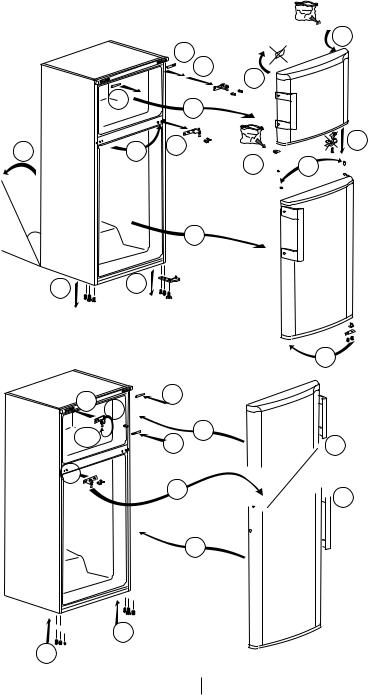
Reversing the doors
Proceed in numerical order .
4
7

 6
6
45°
8 9
18 17 180° 

23
 16 15
16 15 

4 5
2
1
3
19
19 22
21
20
 10
10
10
11
12 
 13
13
14
 24
24
 24
24
12 EN

4 |
Preparation |
|
• |
Your refrigerator should be installed at |
• This product has been designed to |
|
least 30 cm away from heat sources |
function at ambient temperatures |
|
such as hobs, ovens, central heater |
up to 43 °C (90 SDgrF). Even if the |
|
and stoves and at least 5 cm away |
ambient temperature falls to -15 |
|
from electrical ovens and should not |
°C, frozen food in the freezer does |
|
be located under direct sunlight. |
not thaw thanks to its Advanced |
• Please make sure that the interior |
Electronic Temperature Control |
|
|
of your refrigerator is cleaned |
System. For the first installation, the |
|
thoroughly. |
product should NOT be placed under |
• If two coolers are to be installed side |
low ambient temperatures. This is |
|
|
by side, there should be at least 2 cm |
because the freezer cannot go down |
|
distance between them. |
to standard operation temperature. |
• When you operate your refrigerator |
When reaching continuous operation, |
|
|
for the first time, please observe the |
the product can be moved to |
|
following instructions during the initial |
another place. Thus, later you can |
|
six hours. |
place your product in the garage |
• Its door should not be opened |
or an unheated room without the |
|
|
frequently. |
concern of causing frozen food to |
• It must be operated empty without |
get rotten. However, it is likely that |
|
|
placing any food in it. |
above mentioned low temperatures |
• Do not unplug your refrigerator. If |
may cause the freezing of the food in |
|
|
a power failure occurs out of your |
the fridge compartment; thus, please |
|
control, please see the warnings in |
consume the food items in the fridge |
|
the “Recommended solutions for the |
in a controlled way as needed. When |
|
problems” section. |
ambient temperature goes back |
|
|
to normal, you may change button |
|
|
setting according to your need. |
|
|
• If the ambient temperature is below |
|
|
0°C, the food in fridge compartment |
|
|
will freeze. Therefore, we recommend |
|
|
not using the fridge compartment |
|
|
in such low ambient temperatures. |
|
|
You may continue to use the freezer |
|
|
compartment as usual. |
13 EN
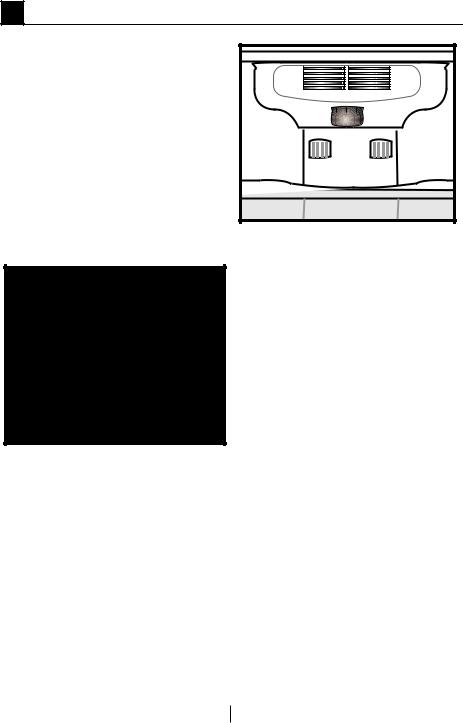
5 Using your refrigerator
Fridge compartment temperature setting button
Temperature button allows you to make the general temperature setting of your refrigerator.
Temperature button of the refrigerator controls both the temperature
of the freezer compartment and the amount of the air send to the fridge compartment and thus, the temperature of the fridge compartment.
At regular room temperatures:
Set the temperature button to a position between “2 and 3” to store your food.
5 |
4 |
3 |
At high room temperatures:
Temperature button must be set to a cooler position if the food is going to be frozen or large amounts of food will be loaded.
If the food in the fridge compartment
cools too much or freezes, temperature button must be set to position “1”.
If the fridge compartment is colder then the required 24 hours after the initial startup, open the lower door and turn the fridge compartment temperature setting button towards to the position “1” and if it is warmer then the required, slightly turn it towards to the position “5”.
14 EN
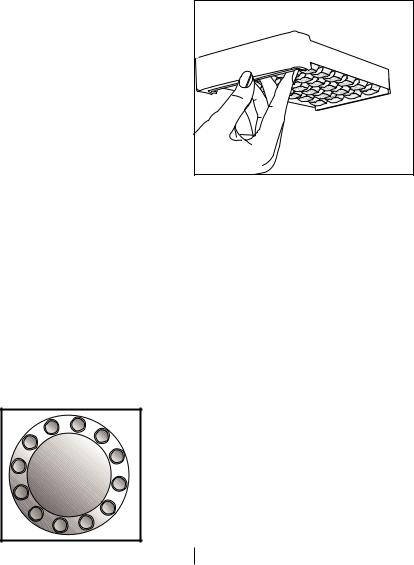
Freezer compartment temperature setting button
Freezer compartment setting button can be set to a position between Normal and Quick Freezing.
•In Normal position, the amount of the air sent to the fridge compartment reaches to maximum.
•In Quick Freezing position, the amount of the air sent to the freezer compartment reaches to maximum. And the amount of the air sent to the fridge compartment decreases to minimum. In this case, the temperature of the fridge compartment will increase. This is normal.
•If you do not need more cooling in either of the compartments, leave the setting button in Normal position.
•In cases where the room temperature is high (25 °C and above), it is suggested to set the freezer compartment setting button to a position near the Normal.
•In low room temperatures, it is suggested to set the freezer
compartment setting button to a position between the Normal and Quick Freezing.
Making ice
*optional
Fill the ice container with water and place it into the freezer compartment. Your ice will be ready approximately in two hours.
You can remove the ice in the ice container by removing it from the freezer and twisting it.
15 |
EN |
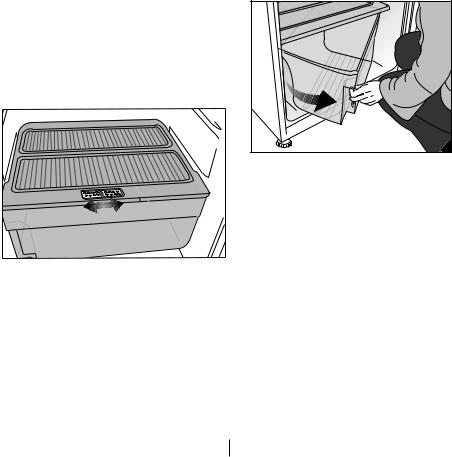
Crisper humidity control sliders
Using the crisper humidity control sliders
Crisper of your refrigerator is designed specially to keep your vegetables fresh without loosing their humidity. Cold air circulates basically around the crisper and the amount of the cold air passing through the crisper is controlled by the sliders on the front side of the crisper cover.
You can adjust the humidity control sliders to a suitable position according to the humidity and cooling condition of your food in the crisper.
If you want your food in the crisper to cool more, open the holes of the humidity control sliders and if you want them to cool less and keep their humidity for a longer time, close the holes.
Using the rotary crisper (in some models)
The crisper of your refrigerator which opens with a rotating movement is designed specially to provide ease of usage and allow you to store more vegetables and fruits (large volume) you buy during large shopping.
When you grab and pull the handle on the lower left hand side of the crisper, it will rotate from left to right and open easily. The separator in the crisper will allow you to separate the vegetables and fruits according to their types and prevent them from crushing.
16 EN

Freezing fresh food
•It must be preferred to wrap or cover the food before placing them in the refrigerator.
•Hot food must cool down to the room temperature before putting them in the refrigerator.
•The foodstuff that you want to freeze must be fresh and in good quality.
•Foodstuff must be divided into portions according to the family’s daily or meal based consumption needs.
•The foodstuff must be packaged in an airtight manner to prevent them from drying even if they are going to be kept for a short time.
•Materials to be used for packaging must be tear-proof and resistant to cold, humidity, odor, oils and acids and they must also be airtight.
Moreover, they must be well closed and they must be made from easy- to-use materials that are suitable for deep freeze usage.
•Frozen food must be used immediately after they are thawed and they should never be re-frozen.
•Please observe the following instructions to obtain the best results.
1.Do not freeze too large quantities of food at one time. The quality of the food is best preserved when it is frozen right through to the core as quickly as possible.
2.Placing warm food into the freezer compartment causes the cooling system to operate continuously until the food is frozen solid.
3.Take special care not to mix already frozen food and fresh food.
Recommendations for preservation of frozen food
•Prepacked commercially frozen food should be stored in accordance with the frozen food manufacturer's instructions for a  ( 4 star) frozen food storage compartment.
( 4 star) frozen food storage compartment.
•To ensure that the high quality achieved by the frozen food manufacturer and the food retailer is maintained, the following should be remembered:
1.Put packages in the freezer as quickly as possible after purchase.
2.Ensure that contents are labeled and dated.
3.Do not exceed "Use By", "Best Before" dates on the packaging.
Defrosting
The freezer compartment defrosts automatically.
17 EN

Placing the food
|
Freezer |
Various frozen food |
|
such as meat, |
|
|
compartment |
|
|
fish, ice cream, |
|
|
shelves |
|
|
vegetables and etc. |
|
|
|
|
|
|
|
|
Egg tray |
Egg |
|
|
|
|
Fridge |
Food in pans, |
|
compartment |
covered plates and |
|
shelves |
closed containers |
|
|
|
|
Fridge |
Small and packaged |
|
food or drinks (such |
|
|
compartment |
|
|
as milk, fruit juice and |
|
|
door shelves |
|
|
beer) |
|
|
|
|
|
|
|
|
Crisper |
Vegetables and fruits |
|
|
|
|
|
Delicatessen |
|
Freshzone |
products (cheese, |
|
compartment |
butter, salami and |
|
|
etc.) |
Deep-freeze information |
||
Food must be frozen as rapidly as possible when they are put in a refrigerator in order to keep them in good quality.
The TSE norm requires (according to certain measurement conditions) the refrigerator to freeze at least 4.5 kg of foodstuff at 32°C ambient temperature to -18°C or lower within 24 hours for every 100-liters of freezer volume.
It is possible to keep the food for a long time only at -18°C or lower temperatures.
You can keep the freshness of food for many months (at -18°C or lower temperatures in the deep freeze).
WARNING! A
•Foodstuff must be divided into portions according to the family’s daily or meal based consumption needs.
•Foodstuff must be packaged in an airtight manner to prevent them from drying even if they are going to be kept for a short time.
•Materials necessary for packaging:
•Cold resistant adhesive tape
•Self adhesive label
•Rubber rings
•Pen
Materials to be used for packaging the foodstuff must be tear-proof and resistant to cold, humidity, odor, oils and acids.
Foodstuff to be frozen should not be allowed to come in contact with the previously frozen items to prevent their partial thawing.
Frozen food must be used immediately after they are thawed and they should never be re-frozen.
18 EN

6 Maintenance and cleaning
A Never use gasoline, benzene or similar substances for cleaning purposes.
B We recommend that you unplug the appliance before cleaning.
B Never use any sharp abrasive instrument, soap, household cleaner, detergent and wax polish for cleaning.
CUse lukewarm water to clean the cabinet of your refrigerator and wipe it dry.
CUse a damp cloth wrung out in a solution of one teaspoon of
bicarbonate of soda to one pint of water to clean the interior and wipe it dry.
B Make sure that no water enters the lamp housing and other electrical items.
B If your refrigerator is not going to be used for a long period of time, unplug the power cable, remove all food, clean it and leave the door ajar.
CCheck door seals regularly to ensure they are clean and free from food particles.
A To remove door racks, remove all the contents and then simply push the door rack upwards from the base.
ANever use cleaning agents or water that contain chlorine to clean the outer surfaces and chromium coated parts of the product. Chlorine causes
corrosion on such metal surfaces.
Protection of plastic surfaces
CDo not put the liquid oils or oil-cooked meals in your refrigerator in unsealed containers as they damage the plastic surfaces of your refrigerator. In case of spilling or smearing oil on the plastic surfaces, clean and rinse the relevant part of the surface at once with warm water.
19 EN

7 Troubleshooting
Please review this list before calling the service. It will save your time and money. This list includes frequent complaints that are not arising from defective workmanship or material usage. Some of the features described here may not exist in your product.
The refrigerator does not operate.
•The plug is not inserted into the socket correctly. >>>Insert the plug into the socket securely.
•The fuse of the socket which your refrigerator is connected to or the main fuse have blown out. >>>Check the fuse.
Condensation on the side wall of the fridge compartment (MULTIZONE, COOL CONTROL and FLEXI ZONE).
•Ambient is very cold. >>>Do not install the refrigerator in places where the temperature falls below 10 °C.
•Door has been opened frequently. >>>Do not open and close the door of refrigerator frequently.
•Ambient is very humid. >>>Do not install your refrigerator into highly humid places.
•Food containing liquid is stored in open containers. >>>Do not store food with liquid content in open containers.
•Door of the refrigerator is left ajar. >>>Close the door of the refrigerator.
•Thermostat is set to a very cold level. >>>Set the thermostat to a suitable level.
•Compressor is not running
•Protective thermic of the compressor will blow out during sudden power failures or plug-out plug-ins as the refrigerant pressure in the cooling system of the refrigerator has not been balanced yet. The refrigerator will start running
approximately after 6 minutes. Please call the service if the refrigerator does not startup at the end of this period.
•The fridge is in defrost cycle. >>>This is normal for a full-automatically defrosting refrigerator. Defrosting cycle occurs periodically.
•The refrigerator is not plugged into the socket. >>>Make sure that the plug is fit into the socket.
•Temperature settings are not made correctly. >>>Select the suitable temperature value.
•There is a power outage. >>>Refrigerator returns to normal operation when the power restores.
The operation noise increases when the refrigerator is running.
•The operating performance of the refrigerator may change due to the changes in the ambient temperature. It is normal and not a fault.
The refrigerator is running frequently or for a long time.
20 EN
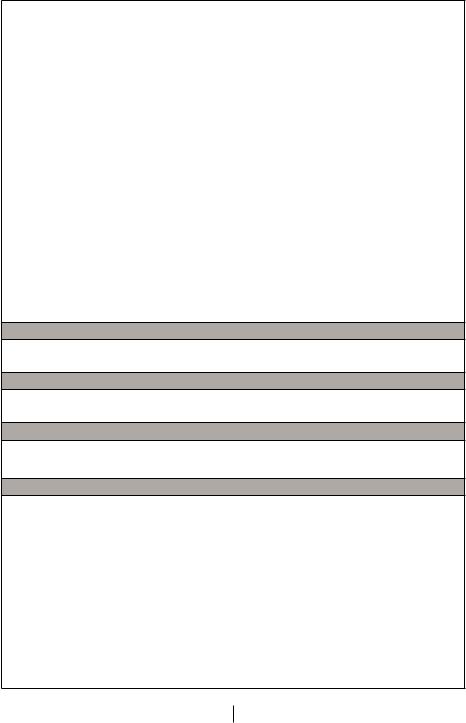
•New product may be wider than the previous one. Larger refrigerators operate for a longer period of time.
•The room temperature may be high. >>>It is normal that the product operates for longer periods in hot ambient.
•The refrigerator might be plugged in recently or might be loaded with food.
>>>When the refrigerator is plugged in or loaded with food recently, it will take longer for it to attain the set temperature. This is normal.
•Large amounts of hot food might be put in the refrigerator recently. >>>Do not put hot food into the refrigerator.
•Doors might be opened frequently or left ajar for a long time. >>>The warm air that has entered into the refrigerator causes the refrigerator to run for longer periods. Do not open the doors frequently.
•Freezer or fridge compartment door might be left ajar. >>>Check if the doors are closed completely.
•The refrigerator is adjusted to a very low temperature. >>>Adjust the refrigerator temperature to a warmer degree and wait until the temperature is achieved.
•Door seal of the fridge or freezer may be soiled, worn out, broken or not properly seated. >>>Clean or replace the seal. Damaged/broken seal causes the refrigerator to run for a longer period of time in order to maintain the current temperature.
Freezer temperature is very low while the fridge temperature is sufficient.
•The freezer temperature is adjusted to a very low value. >>>Adjust the freezer temperature to a warmer degree and check.
Fridge temperature is very low while the freezer temperature is sufficient.
•The fridge temperature is adjusted to a very low value. >>>Adjust the fridge temperature to a warmer degree and check.
Food kept in the fridge compartment drawers is frozen.
•The fridge temperature is adjusted to a very high value. >>>Adjust the fridge temperature to a lower value and check.
Temperature in the fridge or freezer is very high.
•The fridge temperature is adjusted to a very high value. >>>Fridge compartment temperature setting has an effect on the temperature of the freezer. Change the temperatures of the fridge or freezer and wait until the relevant compartments attain a sufficient temperature.
•Doors are opened frequently or left ajar for a long time. >>>Do not open the doors frequently.
•Door is ajar. >>>Close the door completely.
•The refrigerator is plugged in or loaded with food recently. >>>This is normal. When the refrigerator is plugged in or loaded with food recently, it will take longer for it to attain the set temperature.
•Large amounts of hot food might be put in the refrigerator recently. >>>Do not put hot food into the refrigerator.
21 EN

•Vibrations or noise.
•The floor is not level or stable. >>> If the refrigerator rocks when moved slowly, balance it by adjusting its feet. Also make sure that the floor is strong enough to carry the refrigerator, and level.
•The items put onto the refrigerator may cause noise. >>>Remove the items on top of the refrigerator.
There are noises coming from the refrigerator like liquid flowing, spraying, etc.
•Liquid and gas flows occur in accordance with the operating principles of your refrigerator. It is normal and not a fault.
Whistle comes from the refrigerator.
•Fans are used in order to cool the refrigerator. It is normal and not a fault. Condensation on the inner walls of refrigerator.
•Hot and humid weather increases icing and condensation. It is normal and not a fault.
•Doors are opened frequently or left ajar for a long time. >>>Do not open the doors frequently. Close them if they are open.
•Door is ajar. >>>Close the door completely.
Humidity occurs on the outside of the refrigerator or between the doors.
•There might be humidity in the air; this is quite normal in humid weather. When the humidity is less, condensation will disappear.
Bad odour inside the refrigerator.
•No regular cleaning is performed. >>>Clean the inside of the refrigerator regularly with a sponge, lukewarm water or carbonate dissolved in water.
•Some containers or package materials may cause the smell. >>>Use a different container or different brand packaging material.
•Food is put into the refrigerator in uncovered containers. >>>Keep the food in closed containers. Microorganisms spreading out from uncovered containers can cause unpleasant odours.
•Remove the foods that have expired best before dates and spoiled from the refrigerator.
The door is not closing.
•Food packages are preventing the door from closing. >>>Replace the packages that are obstructing the door.
•The refrigerator is not completely even on the floor. >>>Adjust the feet to balance the refrigerator.
•The floor is not level or strong. >>>Make sure that the floor is level and capable to carry the refrigerator.
Crispers are stuck.
• The food is touching the ceiling of the drawer. >>>Rearrange food in the drawer.
22 EN
Veuillez commencer par lire ce manuel d’utilisation!
Cher client,
Nous espérons que votre produit, qui a été fabriqué dans des usines modernes et vérifié au terme des procédures de contrôle de qualité les plus méticuleuses, vous donnera entière satisfaction.
Veuillez donc lire attentivement l'intégralité de ce manuel avant de commencer à utiliser le produit et conservez-le manuel comme référence. Si vous remettez cet appareil à quelqu'un d'autre, remettez-lui également le manuel d'utilisation.
Le présent manuel vous aidera à utiliser votre produit ent toute sécurité et efficacement.
•Lisez le manuel avant d’installer et de faire fonctionner votre produit.
•Veillez à lire les instructions de sécurité.
•ce manuel dans un endroit facilement accessible car vous pourriez en avoir besoin ultérieurement.
•Lisez également la documentation fournie avec le produit.
N'oubliez pas que le manuel d'utilisation est également valable pour plusieurs autres modèles. Les différences entre les différents modèles seront identifiées dans le manuel.
Explication des symboles
Les symboles ci-dessous sont utilisés dans le manuel d'utilisation:
C
A Avertissement relatif aux situations dangereuses pour la vie et la propriété. B Avertissement relatif à la tension électrique.

TABLE DES MATIÈRES
1 Votre réfrigérateur |
3 |
2 Précautions de sécurité |
|
importantes |
4 |
Utilisation préconisée......................... |
4 |
Sécurité générale.............................. |
4 |
Pour les appareils dotés d'une fontaine |
|
à eau ;................................................ |
6 |
Sécurité enfants................................. |
6 |
Conformité avec la règlementation |
|
DEEE et mise au rebut des déchets... |
6 |
Informations relatives à l'emballage.... |
7 |
Avertissement HCA............................ |
7 |
Mesures d’économie d’énergie.......... |
8 |
Recommandations relatives au |
|
compartiment des produits frais......... |
8 |
3 Installation |
9 |
Éléments à prendre en considération |
|
lors du déménagement de votre |
|
réfrigérateur........................................ |
9 |
Avant de mettre votre réfrigérateur en |
|
marche,.............................................. 9 |
|
Branchement électrique................... |
10 |
Mise au rebut de l’emballage............ |
10 |
Mise au rebut de votre ancien |
|
réfrigérateur...................................... |
10 |
Disposition et Installation.................. |
10 |
Remplacement de la lampe ............. |
11 |
Réglage des pieds........................... |
11 |
Réversibilité des portes.................... |
12 |
Réversibilité des portes.................... |
13 |
4 Préparation |
14 |
5 Utilisation de votre |
|
réfrigérateur |
15 |
Bouton de réglage du thermostat du |
|
compartiment réfrigérateur .............. |
15 |
Fabrication de glaçons..................... |
16 |
Bouton de réglage du thermostat du |
|
compartiment de congélation .......... |
16 |
Bac à légumes: utilisation des curseurs |
|
de réglage de l’humidité (dans certains |
|
modèles).......................................... |
17 |
Utilisation du bac à légumes rotatif |
|
(dans certains modèles).................... |
17 |
Système de réfrigération Dual :......... |
18 |
Congélation des produits frais.......... |
18 |
Recommandations concernant la |
|
conservation des aliments congelés.18 |
|
Disposition des denrées................... |
19 |
Informations concernant la |
|
congélation...................................... |
19 |
6 Entretien et nettoyage |
20 |
Protection des surfaces en |
|
plastique. ........................................ |
20 |
7 Dépannage |
21 |
2 FR
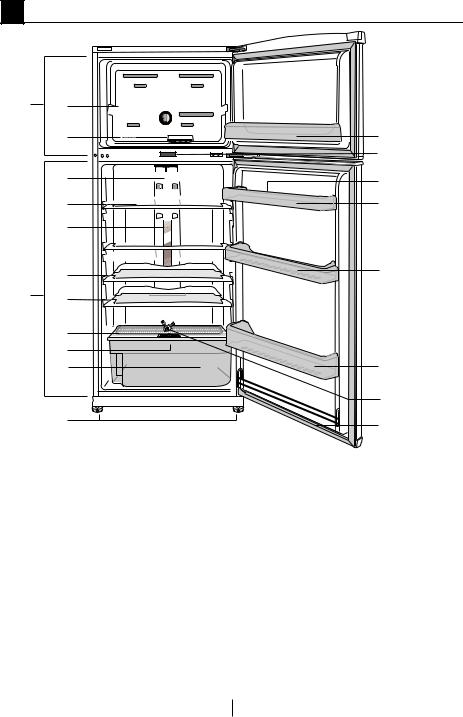
1 Votre réfrigérateur
141 
*2 


3 


4 
5 







 4
4 

4
154
6
7
*8
9
10
*13
11
12
12
12
*13
12
1- Étagère du compartiment congélation
2- Appareil à glaçons
3- Bouton de réglage de la température du compartiment réfrigérateur
4- Étagères réglables
5- Lentilles d’illumination
6- Couvercle du bac à légumes
7- Manette de contrôle d’humidité du bac à légumes
8- Bac à légumes
9- Pieds réglables
10Etagère de la porte du compartiment congélateur
11Casier à œufs
12Etagère de la porte du compartiment de réfrigération
13Verrouıllage
14Compartiment congélateur
15Compartiment réfrigérateur
*EN OPTION
CLes illustrations présentées dans cette notice d’utilisation sont schématiques et peuvent ne pas correspondre exactement à votre produit. Si des pièces présentées ne sont pas comprises dans le produit que vous avez acheté, elles sont valables pour d’autres modèles.
3 FR
2 |
Précautions de sécurité importantes |
|||
Veuillez examiner les informations |
|
(Cela pourrait provoquer des |
|
|
|
engelures dans votre bouche). |
|||
suivantes : Le non respect de ces |
|
|||
|
• Pour les produits équipés d'un |
|||
consignes peut entraîner des blessures |
|
|||
ou dommages matériels. Sinon, tout |
|
compartiment congélateur : ne |
||
|
placez pas de boissons en bouteille |
|||
engagement lié à la garantie et à la |
|
|||
|
ou en cannette dans le compartiment |
|||
fiabilité du produit devient invalide. |
|
|||
|
de congélation. Cela peut entraîner |
|||
Votre appareil a une durée de vie |
|
|||
|
leur éclatement. |
|||
de 10 ans. Pendant cette période, |
|
|||
|
• Ne touchez pas des produits |
|||
les pièces de rechange d'origine |
|
|||
|
congelés avec les mains, ils |
|||
seront disponibles afin que l'appareil |
|
|||
|
pourraient se coller à celles-ci. |
|||
fonctionne comme il se doit. |
|
|||
|
• Débranchez votre réfrigérateur avant |
|||
Utilisation préconisée |
|
|||
|
de le nettoyer ou de le dégivrer. |
|||
Ce produit est prévu pour une |
|
|||
|
• La vapeur et des matériaux de |
|||
utilisation |
|
|||
|
nettoyage pulvérisés ne doivent |
|||
• en intérieur et dans des zones |
|
|||
|
jamais être utilisés pour les processus |
|||
fermées telles que les maisons ; |
|
|||
|
de nettoyage ou de dégivrage de |
|||
• dans les environnements de travail |
|
|||
|
votre réfrigérateur. La vapeur pourrait |
|||
fermées, tels que les magasins et les |
|
|||
|
pénétrer dans les pièces électriques |
|||
bureaux ; |
|
|||
|
et provoquer des courts-circuits ou |
|||
• dans les lieux d'hébergement fermés, |
|
|||
|
des électrocutions. |
|||
tels que les fermes, hôtels, pensions. |
|
|||
|
• Ne jamais utiliser les pièces de votre |
|||
• Il ne doit pas être utilisé en extérieur. |
|
réfrigérateur telles que la porte, |
||
|
|
|
||
Sécurité générale |
|
comme un support ou une marche. |
||
|
• N’utilisez pas d’appareils électriques |
|||
• Avant de vous débarrasser de |
|
|||
|
à l’intérieur du réfrigérateur. |
|||
votre appareil, veuillez consulter les |
|
|||
|
• N’endommagez pas les pièces où |
|||
autorités locales ou votre revendeur |
|
|||
|
circule le liquide réfrigérant avec |
|||
pour connaître le mode opératoire et |
|
|||
|
des outils de forage ou coupants. |
|||
les organismes de collecte agréés. |
|
|||
|
Le liquide réfrigérant qui pourrait |
|||
• Consultez le service après-vente |
|
|||
|
s’échapper si les canalisations de |
|||
agréé concernant toutes questions |
|
|||
|
gaz de l’évaporateur, les rallonges de |
|||
ou problèmes relatifs au réfrigérateur. |
|
|||
|
tuyau ou les revêtements de surface |
|||
N’intervenez pas ou ne laissez |
|
|||
|
étaient percés, peut irriter la peau et |
|||
personne intervenir sur le réfrigérateur |
|
|||
|
provoquer des blessures aux yeux. |
|||
sans le communiquer au service |
|
|||
|
• Ne pas couvrir ou obstruer les orifices |
|||
après-vente agréé. |
|
|||
|
de ventilation du réfrigérateur. |
|||
• Pour les produits équipés d'un |
|
|||
|
• Les appareils électriques peuvent être |
|||
compartiment congélateur : |
|
|||
|
réparés seulement par des personnes |
|||
ne mangez pas de cônes de |
|
|||
|
autorisées. Les réparations réalisées |
|||
crème glacée ou des glaçons |
|
|||
|
par des personnes ne présentant pas |
|||
immédiatement après les avoir sortis |
|
|||
|
les compétences requises peuvent |
|||
du compartiment de congélation ! |
|
|||
|
FR présenter un risque pour l’utilisateur. |
|||
4 |
|
|||
|
||||
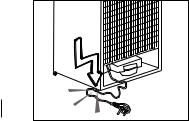
•En cas de dysfonctionnement ou lors d'opérations d’entretien ou de réparation, débranchez l’alimentation électrique du réfrigérateur soit en désactivant le fusible correspondant, soit en débranchant l’appareil.
•Ne tirez pas sur le câble lorsque vous débranchez la prise.
•Placez les boissons alcoolisées verticalement, dans des récipients convenablement fermés.
•Ne conservez jamais des aérosols contenant des substances inflammables et explosives dans le réfrigérateur.
•N’utilisez pas d'outils mécaniques ou autres dispositifs pour accélérer le processus de décongélation autres que ceux qui sont recommandés par le fabricant.
•Ce produit n'est pas conçu pour être utilisé par des personnes (enfants compris) souffrant de déficience physique, sensorielle, mentale, ou inexpérimentées, à moins d’avoir obtenu une autorisation auprès des personnes responsables de leur sécurité.
•Ne faites pas fonctionner un réfrigérateur endommagé. Consultez le service agréé en cas de problème.
•La sécurité électrique du réfrigérateur n’est assurée que si le système de mise à la terre de votre domicile est conforme aux normes en vigueur.
•L’exposition du produit à la pluie, la neige, au soleil ou au vent présente des risques concernant la sécurité électrique.
•Contactez le service agréé quand un câble d'alimentation est endommagé pour éviter tout danger.
•Ne branchez jamais le réfrigérateur
àla prise murale au cours de l’installation. Vous vous exposeriez à un risque de mort ou à de blessures graves.
•Ce réfrigérateur est conçu seulement pour conserver des aliments. Par conséquent, il ne doit pas être utilisé
àd'autres fins.
•L'étiquette avec les caractéristiques techniques est située sur le mur gauche à l'intérieur du réfrigérateur.
•Ne branchez jamais votre réfrigérateur à des systèmes d'économie d'énergie, cela peut l'endommager.
•S’il y a une lumière bleue sur le réfrigérateur, ne la regardez ni avec vos yeux nus, ni avec des outils optiques pendant longtemps.
•Pour les réfrigérateurs contrôlés manuellement, attendez au moins 5 minutes pour allumer le réfrigérateur après une coupure de courant.
•Si cet appareil venait à changer de propriétaire, n'oubliez pas de remettre la présente notice d’utilisation au nouveau bénéficiaire.
•Evitez d'endommager le câble d'alimentation quand vous transportez le réfrigérateur. Tordre le câble peut entraîner un incendie. Ne placez jamais d'objets lourds sur le câble d'alimentation.
•Évitez de toucher à la prise avec des mains mouillées au moment de brancher l'appareil.
5 FR

•Évitez de brancher le réfrigérateur lorsque la prise de courant électrique a lâché.
•Pour des raisons de sécurité, évitez de pulvériser directement de l'eau sur les parties externes et internes du réfrigérateur.
•Ne pulvérisez pas de substances contenant des gaz inflammables comme du propane près du réfrigérateur pour éviter tout risque d'incendie et d'explosion.
•Ne placez jamais de récipients contenant de l'eau sur votre réfrigérateur, ils pourraient causer des chocs électriques ou un incendie.
•Évitez de surcharger le réfrigérateur avec une quantité excessive d'aliments. S'il est surchargé, les aliments peuvent tomber, vous blesser et endommager le réfrigérateur quand vous ouvrez la porte.
•Ne placez jamais d'objets au-dessus du réfrigérateur, ils pourraient tomber quand vous ouvrez ou fermez la porte du réfrigérateur.
•Les produits qui nécessitent un contrôle de température précis (vaccin, médicament sensible à la chaleur, matériels scientifiques, etc.) ne doivent pas être conservés dans le réfrigérateur.
•Si le réfrigérateur n'est pas utilisé pendant longtemps, il doit être débranché. Un problème avec le câble d'alimentation pourrait causer un incendie.
•Le bout de la prise électrique doit être nettoyé régulièrement à l’aide d’un chiffon sec, sinon il peut provoquer un incendie.
•Le réfrigérateur peut bouger si ses pieds réglables ne sont pas bien fixés sur le sol. Bien fixer les pieds réglables sur le sol peut empêcher le réfrigérateur de bouger.
•Quand vous transportez le réfrigérateur, ne le tenez pas par la poignée de la porte. Cela peut le casser.
•Quand vous devez placer votre produit près d'un autre réfrigérateur ou congélateur, la distance entre les appareils doit être d'au moins 8 cm. Sinon, les murs adjacents peuvent être humidifiés.
Pour les appareils dotés d'une fontaine à eau ;
La pression de l’alimentation en eau doit êtrecomprise entre 1 et 8 bars.
• Utilisez uniquement de l’eau potable.
Sécurité enfants
•Si la porte a un verrouillage, la clé doit rester hors de portée des enfants.
•Les enfants doivent être surveillés
et empêchés de s'amuser avec le
produit.
Conformité avec la règlementation DEEE et mise au rebut des déchets
Ce produit ne contient pas de matériaux dangereux et interdits décrits dans la « Règlementation sur le contrôle des déchets d'équipements électriques et électroniques » publié par le Ministère de l'Environnement
et de l'Urbanisme. Conforme avec la règlementation DEEE.
6 FR

Le présent produit a été
fabriqué avec des pièces et du matériel de qualité
supérieure susceptibles d'être réutilisés et adaptés
au recyclage. Par conséquent, nous vous
conseillons de ne pas le mettre au rebut aux côtés des ordures ménagères à la fin de sa durée de vie. Au contraire, rendez-vous dans un point de collecte pour le recyclage de tout matériel électrique et électronique. Veuillez vous rapprocher des autorités de votre localité pour plus d'informations concernant le point de collecte le plus proche. Aidez-nous à protéger l'environnement et les ressources naturelles en recyclant les produits usagés. Pour la sécurité des enfants, coupez le câble d'alimentation et le mécanisme de verrouillage de la porte, le cas échéant. Ce faisant, vous rendez l'appareil inopérant avant sa mise au rebut.
Informations relatives à l'emballage
Les matériaux d'emballage de cet appareil sont fabriqués à partir de matériaux recyclables, conformément à nos Réglementations Nationales en Environnement. Ne mélangez pas les matériaux d'emballage avec les déchets domestiques ou d'autres déchets. Amenez-les aux points de collecte des matériaux d'emballage, désignés par les autorités locales.
N'oubliez pas...
Pour la préservation de la nature et de notre santé, il est indispensable de recycler les matières.
Si vous voulez contribuer au recyclage des matériaux d'emballage, vous pouvez vous renseigner auprès d'organisations environnementales ou de l'autorité locale proche de votre domicile.
Avertissement HCA
Si le système de refroidissement de votre appareil contient R600a :
Ce gaz est inflammable. Par conséquent, veuillez prendre garde à ne pas endommager le système de refroidissement et les tuyauteries lors de son utilisation ou de son transport. En cas de dommages, éloignez votre produit de toute source potentielle de flammes susceptible de provoquer l’incendie de l’appareil. De même, placez le produit dans une pièce aérée.
Ne tenez pas compte de cet avertissement si le système de refroidissement de votre appareil contient R134a.
Le type de gaz utilisé dans l'appareil est mentionné sur la plaque signalétique située sur la paroi gauche de l'intérieur du réfrigérateur.
Ne jetez jamais l'appareil au feu pour vous en débarrasser.
7 FR
